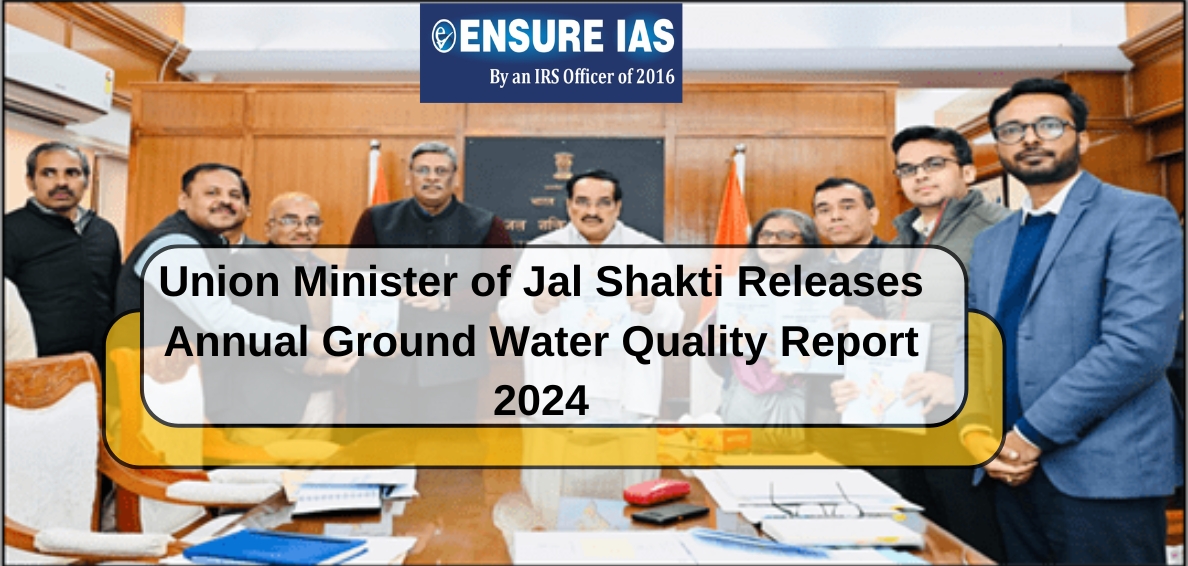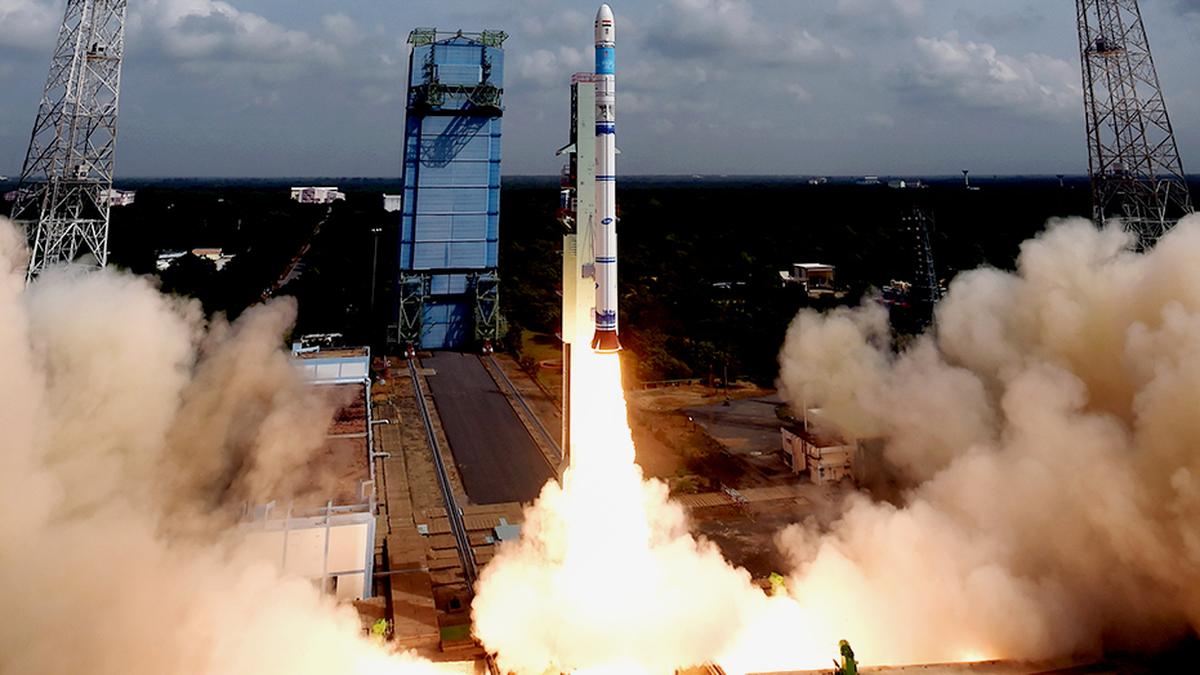- Courses
- GS Full Course 1 Year
- GS Full Course 2 Year
- GS Full Course 3 Year
- GS Full Course Till Selection
- Answer Alpha: Mains 2025 Mentorship
- MEP (Mains Enrichment Programme) Data, Facts
- Essay Target – 150+ Marks
- Online Program
- GS Recorded Course
- Polity
- Geography
- Economy
- Ancient, Medieval and Art & Culture AMAC
- Modern India, Post Independence & World History
- Environment
- Governance
- Science & Technology
- International Relations and Internal Security
- Disaster Management
- Ethics
- NCERT Current Affairs
- Indian Society and Social Issue
- NCERT- Science and Technology
- NCERT - Geography
- NCERT - Ancient History
- NCERT- World History
- NCERT Modern History
- CSAT
- 5 LAYERED ARJUNA Mentorship
- Public Administration Optional
- ABOUT US
- OUR TOPPERS
- TEST SERIES
- FREE STUDY MATERIAL
- VIDEOS
- CONTACT US
Union Minister of Jal Shakti Releases Annual Ground Water Quality Report 2024
Union Minister of Jal Shakti Releases Annual Ground Water Quality Report 2024
06-01-2025

- In January 2025, the Central Ground Water Board (CGWB) released the Annual Ground Water Quality Report, 2024, highlighting a significant rise in groundwater contamination across India.
- The report reveals a troubling increase in nitrate levels, with 56% of the country’s districts exceeding safe limits. This poses serious health risks, particularly to children, and threatens ecosystems and agricultural productivity.
- Alongside nitrates, contaminants like fluoride and uranium aggravate the crisis, especially in regions with over-exploited aquifers.
Key Findings of the CGWB Report
- Rising Nitrate Contamination: As of 2023, 440 districts reported nitrate levels exceeding the safe limit of 45 mg per litre (mg/L), up from 359 districts in 2017.
- 19.8% of the 15,239 groundwater samples collected nationwide had nitrate levels above permissible limits, a minor reduction from 21.6% of 13,028 samples in 2017.
- Regional Hotspots: Rajasthan (49%), Karnataka (48%), and Tamil Nadu (37%) reported the highest levels of nitrate contamination.
- Central and Southern India, including Maharashtra (35.74%), Telangana (27.48%), and Andhra Pradesh (23.5%), are experiencing increasing nitrate levels.
- Rajasthan, Madhya Pradesh, and Gujarat face persistent issues due to geological factors.
- Monsoon Influence: Contamination worsens after the monsoon, with 32.7% of samples exceeding safe nitrate levels compared to 30.8% pre-monsoon.
- Other Contaminants: Fluoride contamination is prevalent in Rajasthan, Haryana, Karnataka, Andhra Pradesh, and Telangana.
- Uranium levels exceeding 30 parts per billion (ppb) are prominent in over-exploited zones in Rajasthan, Punjab, Haryana, Gujarat, Tamil Nadu, Andhra Pradesh, and Karnataka.
- Groundwater Extraction: The stage of groundwater extraction remains steady at 60.4% since 2009.
- 73% of blocks are classified as “safe” in 2023, a notable improvement from 67.4% in 2022.
What are Nitrates?
- Nitrates (NO₃) are compounds of nitrogen and oxygen, naturally found in soil, air, and water.
- They are essential for plant growth, but excessive amounts can harm human health and ecosystems.
-
Sources of Nitrate Pollution
|
Type |
Sources |
|
Agricultural Practices |
|
|
Industrial and Urban Activities |
|
|
Natural and Environmental Factors |
|
|
Geogenic Factors |
|
What are the Health and Environmental Impacts?
Health Risks:
- Methemoglobinemia (Blue Baby Syndrome): High nitrate levels reduce the oxygen-carrying capacity of blood in infants, causing severe health issues.
- Low oxygen levels in body tissues result in bluish skin, especially in infants (blue-baby syndrome).
- Chronic Health Conditions: Excessive nitrate intake can harm the respiratory, reproductive, and nervous systems and cause kidney toxicity and thyroid issues.
- Gastrointestinal and Neurological Issues: Prolonged exposure can lead to chronic illnesses.
Environmental Impacts:
- Eutrophication: Excess nitrates in water bodies trigger algal blooms, reducing oxygen levels and harming aquatic ecosystems.
- It is a process where water bodies become nutrient-rich (mainly nitrogen and phosphorus), causing algal overgrowth.
- Soil Degradation: Long-term exposure to contaminated water depletes soil nutrients, affecting agricultural productivity.
- Ecosystem Damage: Contaminants harm aquatic life, reduce biodiversity, and disrupt ecosystems.
Economic Consequences:
- Increased costs for treating water-related illnesses and contamination mitigation.
- Reduced agricultural yields and food safety concerns from using polluted water.
What are the other Groundwater Contaminants?
- Fluoride: Causes skeletal fluorosis, neuromuscular issues, and dental deformities.
- Uranium: Leads to kidney toxicity and chronic health issues.
- Radon: A radioactive element increasing the risk of lung cancer.
- Arsenic: Linked to cancer, skin diseases and chronic conditions like black foot disease.
Central Ground Water Board (CGWB)
|
Government Initiatives and Measures
National Programs:
- National Aquifer Mapping Programme (NAQUIM): Maps and characterizes aquifers to improve water management.
- National Rural Drinking Water Programme (NRDWP): Focuses on tackling contamination like fluoride and arsenic through water treatment plants and alternative sources.
- Jal Kranti Abhiyan: Promotes integrated water conservation and management.
- Atal Bhujal Yojana (ABHY): Promotes sustainable groundwater practices in over-exploited areas.
- Jal Shakti Abhiyan: A comprehensive program for water conservation and groundwater replenishment.
- Namami Gange: Focuses on cleaning the Ganga basin and mitigating groundwater contamination.
Pollution Control Efforts:
- Installation of Sewage Treatment Plants (STPs) and Effluent Treatment Plants (ETPs).
- Enforcement of the Water (Prevention & Control) Act, 1974 by the Central Pollution Control Board (CPCB) and state authorities.
Policy Recommendations
- Regulating Fertilizer Use: Promote sustainable agricultural practices to reduce nitrogenous fertilizer overuse. Encourage precision farming and organic alternatives.
- Promoting Groundwater Recharge: Accelerate rainwater harvesting and Managed Aquifer Recharge (MAR) projects.
- Improved Monitoring: Enhance monitoring systems for groundwater quality and contamination sources.
- Public Awareness and Education: Conduct community outreach programs under campaigns like Catch the Rain and Swachh Bharat Mission.
- Efficient Waste Management: Develop robust waste treatment systems, especially in urban areas. Focus on decentralized waste treatment and recycling initiatives.
Conclusion
The rising levels of nitrate and other contaminants in India’s groundwater requires the need for immediate action. While the CGWB’s robust monitoring system provides valuable insights, implementation of targeted measures is crucial. By fostering sustainable agricultural practices, improving waste management, and investing in groundwater replenishment, India can mitigate this crisis and safeguard its most vital resource for future generations.
|
Also Read |
|



